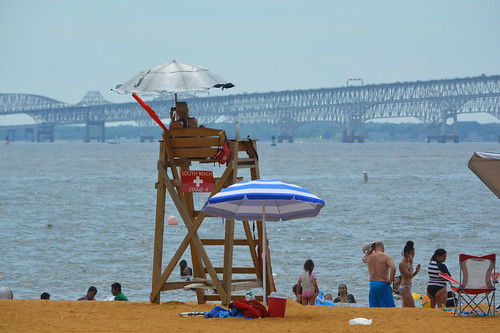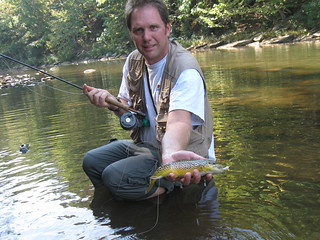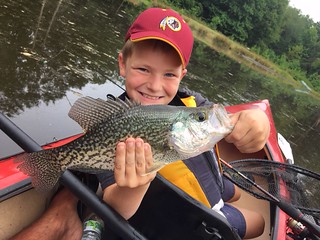Maryland Fishing Report: July 18
We’ve all learned in our lives that nothing ever stays the same, and this certainly holds true for the Chesapeake Bay. She started out as a river valley and became flooded after the last ice age to become the largest estuary in the United States.
The view from a drive across the Chesapeake Bay Bridge shows how much this treasure means to so many people — bulk carrier ships anchored and waiting to pick up their cargo, fleets of sailboats off the mouth of the Severn River, commercial crab boats tending their strings of traps, anglers fishing near the piers and throngs of people enjoying Sandy Point State Park.
More than 18 million people live in the Chesapeake Bay Watershed. The bay has had a difficult time putting up with us, but she always promises hope and keeps showing us that she is resilient.
It’s just a simple fact; we are all part of the bay’s problems and can be part of the solution. We’ve learned from our past mistakes and implemented policies and management that have seen the resurgence of underwater grass beds in the bay, protection and growth of critical forests and wetlands, and the restoration of fish populations. One thing doesn’t change – the bay teaches us that hope springs eternal.
Weekly Fishing Conditions Forecast Summary: July 18-24
Scarce oxygenated, cool water conditions continue to force bay rockfish into smaller and smaller areas. With the water getting closer to temperatures rockfish will avoid — 84 degrees or higher — stick to the mainstem of the bay and seek out the coolest water with adequate oxygen available that combines excellent structure, moving water and bait. Focus your fishing times to low light periods when nighttime temperatures provide limited relief for hungry gamefish.
Expect the continued hot, sunny weather to continue to push water temperatures toward the mid 80s. Anglers will experience typical summer temperatures in the mid to upper 80s for most of this upcoming week with a good chance of daily thunderstorms from Saturday through Tuesday. There will be above average tidal currents Monday and Tuesday as a result of the upcoming full moon July 28.
For the full weekly fishing conditions summary and more detailed and up-to-date fishing conditions in your area of the bay, be sure to check out Eyes on the Bay’s Click Before You Cast.
Upper Chesapeake Bay
The upper bay striped bass fishery right now is exhibiting what fisheries biologist Chuck Coutant in the mid-1980s called “habitat squeeze.” Basically we’ve had large algae blooms as a result of May’s heavy rains and subsequent runoff, and those algae are now dying and using up valuable oxygen in the deeper and cooler waters of the bay. The striped bass are now holding in waters often less than 16 feet to find sufficient dissolved oxygen, but those waters are exhibiting temperatures around 81 degrees at the moment. The highest water temperature striped bass can tolerate is 84 degrees. The striped bass are stuck in this shallow region of the upper bay from Swan Point north to Pooles Island with no escape avenue. These high water temperatures and low salinity values will cause mortalities from stress and you might also see more visible sores on the fish. Unfortunately the larger striped bass, those 24 inches or better, will have the most difficulty with these water-related stress conditions.
Chumming has been the most popular way to fish for striped bass in the upper bay with the fish concentrated in a relatively small area. A high ratio of sub-legal fish is common, and unfortunately catch-and-release stress on these fish can also be a problem. Anglers catching a sub-legal rockfish are urged to not handle the fish or bring it in the boat, but to release it in the water. Fishermen are also advised not to practice catch-and-release fishing with rockfish after reaching their two-fish limit. Don’t forget there are other species of fish to catch in the upper bay, with a good white perch bite, which is fun for the kids.
It is important to be prepared with a dehooking device and or needle-nosed pliers. Disturbing the slime layer on the fish will increase the possibility of sores occurring in the warm water and low salinity conditions.
We remind you to use circle hooks of suitable size, with a recommended size of 9/0-10/0. This will help to avoid gut-hooking. Anglers should resist the instinct of trying to set the hook when a fish picks up a bait, just tighten up the line and let the fish hook itself.
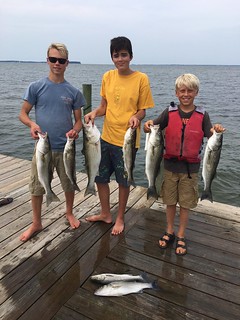
Daniel and Jonathan Irons of Queenstown, along with their dad, took their friend Christer Lindengren out for a great day of striped bass fishing. The two fish on the dock belong to the photographer. Photo by Mike Irons
Also there are a lot of different circle hook designs out there, such as “Octopus” hooks, and some of them are actually a “hybrid” between J and circle hooks. The point of the hook should be pointing perpendicular to the shank of the hook.
Finally, many captains have learned to snell their circle hooks to the leader to ensure a straight pull, which seems to help a lot with the hook engaging the side of the mouth properly. Anglers will also learn the best ways of placing the circle hook in a bait by experience, and when live lining always remember when a fish is swallowing a prey fish they swallow it head first, so try hooking your live bait more toward the tail end.
There has been a little striped bass chumming occurring at Love Point but there are very few fish there and they are holding in water shallower than 16 feet. Trolling can be an option at traditional locations such as Love Point and the Triple Buoys with gold spoons and red or green hoses. Jigging can be an option near the Francis Scott Key Bridge as well as live lining small white perch and eels.
The eastern side of the Bay Bridge has been a place to try chumming and jigging where striped bass are suspended around 10 feet to 15 feet. The sewer pipe is also a good place to give it a try. On the western side of the bridge, fishing for white perch in 10 to 12 feet of water can provide some fun family fishing. Bottom rigs baited with bloodworms are the typical setup.
Recreational crabbing has been improving in the upper bay with catches ranging from a few dozen to a half bushel per trip.
It is no secret that most of the striped bass chumming attention is focused on the upper bay, but there are a few alternatives for those wishing to fish closer to home and save some fuel. The edges of Thomas Point and Tilghman Point in Eastern Bay offer some early morning chumming action. There are good numbers of spot in the Choptank River inside of Black Walnut Point, in an area known as the sands. The spot can be live lined at the those locations, or if the spot are too large they can be used as fresh cut bait or even better yet wind up in a frying pan. Bloodworms are the bait of choice to catch them on a bottom rig.
Trolling can be an option along shallower edges at the mouths of the tidal rivers. Small gold spoons or those with chartreuse on them are a good choice. Red and green hoses and diving jerkbaits or bucktails dressed with sassy shads or swimshads are all good choices to troll.
The shallow-water striped bass fishery is a productive and fun way to fish with light tackle this week, but it means getting out on the water before dawn. Usually when the sun rises above the horizon it is all over and fish have retreated to deeper waters. Topwater lures are a favorite and will also keep one out of the grass.
The best chumming fishing for striped bass is now occurring in the lower Potomac River near St. Georges Island and Cobb Island, along the steep channel edge there. There is also good chumming at the mouth of the Potomac and a few bluefish are now coming into the chum slicks. Throwback ratios are high on the striped bass and some are live lining spot in search of a better grade of fish.
Trolling is a viable option — gold spoons, red and green hoses and swimshads are favorites this week. Casting to shoreline structure in the early morning hours for striped bass has been a productive and fun way to fish. A variety of topwater lures, swimshads and crankbaits have been popular lures. As is typical this time of the year the action winds down once the sun rises above the horizon.
Bottom fishing for a mix of spot, croaker and white perch has been very good in the lower Patuxent and Potomac with blue catfish also being part of the mix at times. Bloodworms are the preferred bait for the spot and white perch, peeler crab will catch croakers and the blue catfish prefer fresh cut bait such as spot, but often pick up any good-smelling bait.
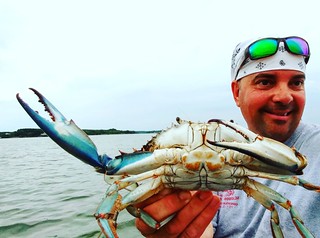
The Miles River crabs have been living up to their reputation for size as Rich Watts takes a selfie with this big jimmy. Photo by Rich Watts
Over on the eastern side of the bay there has been exceptional fishing for spot in the Tangier and Pocomoke sound areas, with a mix of croaker and white perch in the mix in certain areas. A few flounder catches have been reported from the hard edges channel edges and small bluefish are becoming more common. The shallow water fishery for striped bass has wound down due to warm water temperatures but there is still some action in the pre-dawn hours. A few speckled trout are being caught by drifting soft crab or peeler crab baits in the creeks or on Gulp swimbaits. There have been a few scattered reports of cobia around the Middle Grounds and the Target Ship.
Recreational crabbing continues to gain speed in the tidal rivers and creeks this week. The best crabbing success is coming from the lower bay and middle bay regions, with a full bushel of crabs possible per outing.
Razor clams tend to out-catch chicken necks but if you have plenty of time, one can put together a full bushel catch with chicken necks, just make sure the chicken necks are fresh.
Fishing for white perch with light tackle in the shallow water shoreline areas is an early morning venture this week as warm water temperatures tend to push the white perch into deeper waters during the day. Evenings can be good also and small spinnerbaits are the best way to fish. During the day, hard bottom areas with decent oxygen levels will hold white perch. Bloodworms tend to be the best bait to use on a bottom rig.
Reports from Deep Creek Lake fishermen speak of good walleye fishing in 10 to 15 feet of water along rocky points. Slow trolling yellow perch patterned jerkbaits is a proven method of fishing for these walleyes. Smallmouth bass can also be caught using this method or by jigging crawfish imitations. Large bluegills and yellow perch can also be found in these deeper waters using small minnows or night crawlers. Largemouth bass and pickerel are entertaining anglers in the early morning and late evening hours in shallow coves with weed beds. During brighter sun conditions largemouth bass can be found seeking cool shade under floating docks or fallen treetops. Flipping a variety of soft plastics and stick worms to such areas is a good way to fish for bass.
Fly fishermen are finding some fun dry fly fishing in many of the western region trout management waters this week. Reports say that trout are rising to several hatches on area streams and rivers, blue wing olives are hatching in the early mornings and spinners are falling to the water’s surface in the evening, providing a feast for rising trout. Sulphurs are reported to be hatching on the Savage River. Casting streamers can also be a productive way to fish this time of the year since trout will strike eagerly for what they think are bait fish, small spinners are a great option for spin cast fishermen. Always make sure to know the specified fishing gear and trout possession options on the trout management waters you are fishing. The Maryland Fishing Guide is your best source for this information.
Largemouth bass are of course locked into their typical summer mode of behavior. That usually includes forays into shallow water areas during the evening hours to early morning hours searching for prey items. The early morning hours before sunrise tend to offer the best shallow water fishing. This is the time to be casting buzzbaits, frogs, poppers and lipless crankbaits near shallow grass, lily pad or spatterdock fields. As the sun rises in the sky, largemouth bass will retreat to thick overhead grass in slightly deeper water, deeper sunken wood, fallen tree tops or shade under docks or brush. The endeavor is to find cool shade to sit out the day until the late evening hours.
Due to the fact these largemouth bass are resting, the pickup of any lure will be subtle. Dropping stick worms or soft plastics down through thick grass mats is a good tactic. The same lures or grubs will also do the trick near sunken wood, under the shade of docks or brush. In tidal areas if one can match up a falling tide with early morning fishing; casting spinnerbaits or jerkbaits along the outside edges of spatterdock fields can be very productive.
Warm summer days are a wonderful time to explore local lakes and ponds or perhaps gear up for an adventure in a region where you’ve never fished. Kayaks and canoes or a small aluminum boat are a great way to spend a quiet day out on the water with family and friends. We are more than halfway through our youngest anglers’ summer vacation so pack up a lunch and plenty of water and spend some fun time.
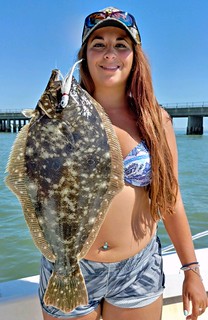
Angelina Watts jigged up this nice flounder while fishing with her dad near Ocean City. Photo by Rich Watts
Surf fishermen are catching a few kingfish on bloodworm baits or small strip baits in the early morning hours. Water temperatures are elevated enough now that fishing tends to be poor during the heat of the day. There is also a mix of flounder and blowfish being caught and in the evening hours inshore shark species can provide some catch-and-release entertainment.
At the inlet most of the action tends to be at the South Jetty for a mix of sheepshead, flounder and tautog. Triggerfish and small black drum are also becoming more common for those fishing with sand fleas. There is some striped bass and bluefish action in the evenings when boat traffic settles down. Casting swimshads, bucktails or drifting fresh cut bait or eels have been the best ways to fish for them.
Flounder fishing has been good at the inlet and the back bay channels this week. The water has been clear, which an important factor. Traditional baits of squid and minnows catch a lion’s share of flounder in the Ocean City region, but 6-inch white Gulp baits on a jig head or bottom rig tend to catch the largest flounder.
Outside of the inlet there is still some wonderful trolling action for a mix of Spanish mackerel and bluefish on the various shoal areas off Ocean City. Silver spoons behind inline weights with plenty of wire have been the best setup to get in on the action.
Farther offshore at the wreck and reef sites the party boats are finding a mix of flounder, triggerfish and a few sea bass for their patrons. Many of the flounder being caught are rather large and being caught on squid strip baits. Some of the boats have been taking the trek to deeper waters and finding greater number of larger sea bass. Those deep dropping near the canyon edges are catching blueline tilefish.
Those trolling at the canyon regions from the Baltimore to Norfolk have been catching a mix of blue and white marlin, yellowfin tuna and dolphin. At Poormans Canyon, the lobster buoys there are attracting and holding chicken dolphin which can provide a lot of fun on light tackle and some fine eating.
“The expert angler isn’t necessarily a guy who always does the right thing at the right second. But one thing he necessarily is, and that’s a fishing man!” — Philip Wylie
 ABOUT THE AUTHOR Keith Lockwood has been writing the Fishing Report since 2003 and has had a long career as a fisheries research biologist since 1973. Over the course of his career he has studied estuarine fishery populations, ocean species, and over a decade long study of bioaccumulation of chemicals in aquatic species in New Jersey. Upon moving to Oxford on the eastern shore of Maryland; research endeavors focused on a variety of catch-and-release studies as well as other fisheries related research at the Cooperative Oxford Laboratory. Education and outreach to the fishing public has always been an important component to the mission of these studies. Keith is an avid outdoorsman enjoying hunting, fishing, bird dogs, family and life on the eastern shore of Maryland.
ABOUT THE AUTHOR Keith Lockwood has been writing the Fishing Report since 2003 and has had a long career as a fisheries research biologist since 1973. Over the course of his career he has studied estuarine fishery populations, ocean species, and over a decade long study of bioaccumulation of chemicals in aquatic species in New Jersey. Upon moving to Oxford on the eastern shore of Maryland; research endeavors focused on a variety of catch-and-release studies as well as other fisheries related research at the Cooperative Oxford Laboratory. Education and outreach to the fishing public has always been an important component to the mission of these studies. Keith is an avid outdoorsman enjoying hunting, fishing, bird dogs, family and life on the eastern shore of Maryland.

